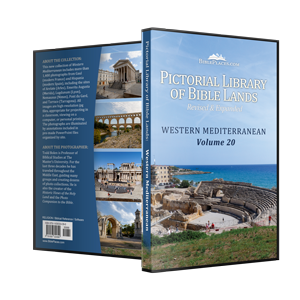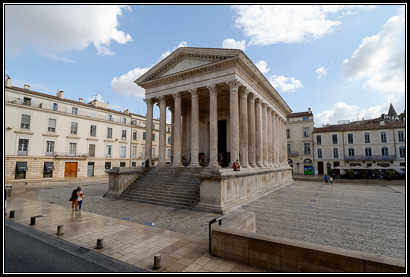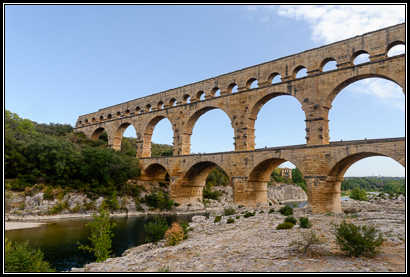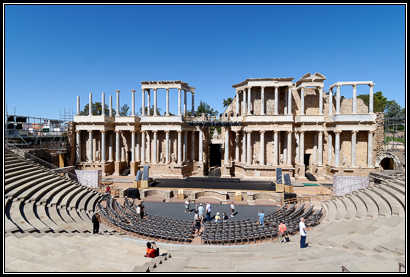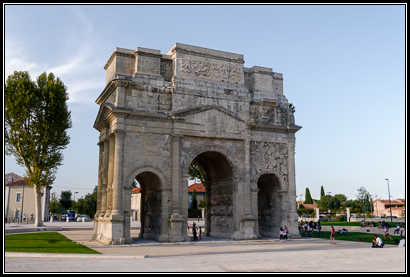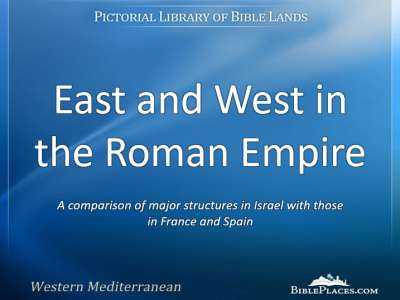I love the Roman ruins in the lands of Israel, Jordan, Egypt, and Turkey. I’ve visited these sites many times, and the standing Roman remains are usually much more interesting to a photographer than the poorly preserved rubble from the Bronze and Iron Ages. Tourists often say that their favorite stops are the sites with the most impressive architecture, such as Caesarea and Beth Shean. In Jerusalem, the story is much the same—the walls of the Temple Mount elicit more dropped jaws than do the Broad Wall or the Stepped Stone Structure.
BiblePlaces Newsletter
Vol 19, #3 - June 22, 2020
And yet, as impressive as Rome is in the East, it’s that much more so in the West. Until last year, I had never been further West than Rome—and I don’t mean growing up in California or visiting the Eiffel Tower—I’m talking about seeing the sites of the Roman Empire west of Rome.
What I saw in the West helped me better understand the East. In the East, you have the walls of a temple platform, but in the West, you have the temple! In the East, you have the seats of a theater, but in the West, you have the entire theater, including its scenae frons. Being at an archaeological site is so much better when you’re not squinting at some guide’s reconstruction drawing, trying to imagine what a structure was like, because you can actually see the intact structure right in front of you.
I am going to share some specific examples today in a reflection below called “The Roman Empire: East vs. West.” There is an accompanying PowerPoint (download here) that might be compared with “Then and Now” presentations we have done in the past, except that this one is more like “Here and There,” providing a geographical contrast instead of a chronological one.
These photos are a sampling from our new Western Mediterranean collection. If you are inclined to purchase this collection, now is the cheapest opportunity to do so, with the $25 sale price ending tomorrow.
Todd Bolen
Photographer, BiblePlaces.com
Professor of Biblical Studies, The Master’s University
The Roman Empire: East vs. West
In last week’s newsletter, I explained how the Roman sites in the Western Mediterranean help us to better understand and appreciate Paul’s desire to visit Spain. A second contribution of the Western Mediterranean world to biblical studies is the well-preserved Roman remains. Whether the result of more frequent conflicts, earthquake activity, or pillaging, well-preserved sites in the eastern half of the Roman world are far less common. How is one to visualize a Roman imperial temple when one visits Caesarea Maritima and sees not one stone left upon another? The situation is no better at the temple Herod built at Caesarea Philippi. At Samaria (Sebaste), a monumental staircase is preserved, but little more.
But in France, one can marvel at the imperial temple in Nîmes—so well-preserved that Thomas Jefferson had the Virginia State Capitol designed after it. Two other imperial temples still stand: one in Vienna, France, and the other in Emerita Augusta in Spain. All three of these were built during the reign of Augustus, about the time of Jesus’s birth.
Imperial Temple in Nîmes (ancient Nemausus). Constructed shortly before Jesus’s birth in Bethlehem, the temple was dedicated by Emperor Augustus to his adopted sons Gaius and Lucius. Nemausus is my favorite site in ancient Gaul, and this imperial temple is only one of the reasons.
Parts of Roman triumphal arches are preserved in Jerusalem, one under the Damascus Gate and the other the famous, but misnamed, Ecce Homo Arch. Across the Jordan in Jerash, there’s a nicely preserved arch from the time of Hadrian. But none of these compares with the arch in Orange in ancient Gaul. Back in Jerusalem, the so-called Pillar of Absalom is impressive (and well-preserved), but the mausoleum of Glanum is superior.
Theaters abound throughout the Roman Empire, but two of the best are in Orange and Emerita Augusta. The same goes for amphitheaters. The best in Israel is at Beth Shean, with others at Caesarea and Beth Guvrin, but none of these is as impressive as those at Nîmes, Arles, or Emerita Augusta.
The Romans built aqueducts in Israel, and the most scenic is at Caesarea, but it cannot compare with those at Lugdunum, Tarraco, or most spectacularly, Pont du Gard. The comparisons can go on, with Roman bridges, obelisks, cryptoporticoes, and mosaics.
The Pont du Gard is the “bridge over the Gard River.” Built about the time Paul was beginning his missionary journeys (AD 50), this aqueduct system carried water a distance of 35 miles (55 km) to the Roman city of Nemausus. Today more than a million visitors come annually to see this marvel of Roman engineering.
The point is this: it is easier to appreciate and understand the might and glory of the Roman Empire when looking at more fully preserved remains. You don’t need to imagine the scenae frons of a theater, or the posthole to support the vellum roof at an amphitheater, or the martial reliefs on the triumphal arches when these can still be seen today. You can actually walk through the “gate of death” in the amphitheater, gaze up at the Corinthian columns of a temple, and examine the details of intricate mosaics.
I do not mean to suggest these do not exist in the eastern half of the Roman world, but my experience was one of regular amazement in seeing buildings and monuments that I had previously known only in examples that are more poorly preserved. These are the subjects I tried to capture with my camera. My hope is that these photos will provide students and teachers with striking images of buildings and sites and scenes many do not realize exist or know are relevant to New Testament studies.
I learned more than this. I enjoyed tracing the Roman routes through Gaul and Hispania, seeing how they connected all the major centers of Roman life. I felt a sense of satisfaction in visiting Vienna, the city in Gaul where Herod Archelaus was banished after his failed attempt to rule Judea, not long after Joseph and Mary chose not to return to Bethlehem because of his evil rule (Matt 2:22). I was moved by my visit to the amphitheater in Lugdunum (modern Lyon), famous for the death of 48 martyrs during the time of Irenaeus in AD 177. And I enjoyed bush-whacking my way through tall reeds to stand before a Roman bridge near ancient Ugia and see a rare in situ inscription with Augustus’s name.
The Western Mediterranean regions of Gaul and Hispania have much to offer the student of the New Testament, and I am excited to be able to share this photo collection in an effort to extend the usefulness and scope of the Pictorial Library of Bible Lands.
Featured BiblePlaces Photos:
East vs. West
The featured photos in this newsletter show the contrast between remains of significant monuments in Israel (the East) with those in Gaul and Hispania (the West). Download our free “East and West in the Roman Empire” PowerPoint to see the striking difference. For more than 1,400 photos of the West, order the new Western Mediterranean volume in the Pictorial Library of Bible Lands.
The sale ends Tuesday for our launch price of $25 for the Western Mediterranean volume. Purchase includes immediate download and free shipping. This unique collection includes more than 1,400 photos and 25 PowerPoints of major Roman sites in Gaul (France) and Hispania (Spain). Purchase the collection as a DVD+download or download-only.
SHARE THIS NEWSLETTER
Do you know someone who would enjoy this newsletter? Feel free to pass it on to friends you think might appreciate it. They can subscribe here.
The BiblePlaces Newsletter is cost-free and spam-free. Email addresses will never be used for any purpose other than this newsletter. If you have questions about the subscription process, see this page.
All contents © 2020 Todd Bolen. Text and photographs may be used for personal and educational use with attribution. Commercial use requires written permission.
